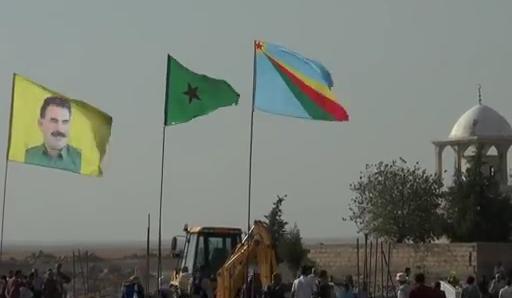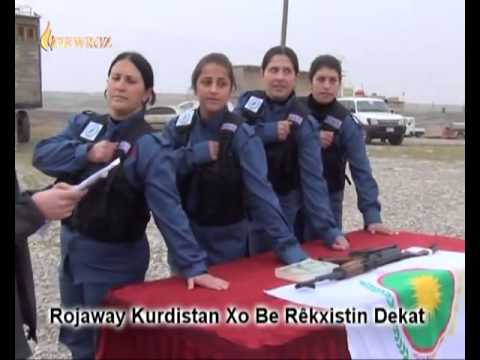
image located by Hoang Nhan Nguyen, 01 July 2014

Last modified: 2014-10-11 by zoltán horváth
Keywords: kurd |
Links: FOTW homepage |
search |
disclaimer and copyright |
write us |
mirrors
See also:

image located by Hoang Nhan Nguyen, 01 July 2014
Help me to identify two flag on the image taken from the footage of VICE News.
Hoang Nhan Nguyen, 01 July 2014
Well, they're definitely Kurdish. The one on the left is a portrait flag of PKK leader Abdullah Ocalan. The middle one appears to be a variant of the green flag of its affiliate the KKK, but without the yellow sun on which the red star is usually placed. The right one is a novelty, but it has the KKK sun+star in the farthest corner of its canton.
Eugene Ipavec, 01 July 2014
I have several questions regargding that image: 1. Can you provide the original link of VICE news that Mr. Nguyen Hoang Nhan mentions? 2. I see an Abdullah Öcalan flag (first flag from left to right, like the ones post here as the Öcalan flag. It is possible that the other two flags may also be of Turkish origin, rather than Syrian, but do we have the location of where this picture was taken? Perhaps if we identify the place we may have a better chance of identifying the other two flags.
Esteban Rivera, 01 July 2014
The video you
mention is taken on "Syrian
Kurdistan or Western Kurdistan (Kurdish: Rojavayê Kurdistan), also
commonly referred to as simply Rojava meaning the West in Kurdish, is a de facto
autonomous region in northern and north-eastern Syria".
Regarding the flags in this video, they are the flags of the "Democratic
Union Party (Kurdish: Partiya Yekîtiya Demokrat, PYD; Arabic:
حزب الاتحاد الديمقراطي - Ḥizb Al-Ittiḥad
Al-Dimuqraṭiy) ) is a Syrian Kurdish political party established in 2003 by
Kurdish activists in northern Syria. An affiliate of the
Kurdistan Workers' Party (PKK) and a founder member of the National
Coordination Body for Democratic Change, it is described by the Carnegie Middle
East Center as "one of the most important Kurdish opposition parties in Syria".
It is said to control a number of towns in northern Syria." Sources:
Democratic Union Party
The PYD "is basically ruling over the Northwestern part of the country. Since
the start of the
Syrian Civil War in 2012 the PYD has quietly constructed its own government
in Syria including an army (YPG), police force (Asayis), and even conducts it's
own foreign policy." Source:
Rise of the PYD in Syria.
So the flags in the Youtube video that you mention from VICE news, are:

image located by Esteban Rivera, 03 July 2014
I forgot to mention one more flag featured in this video (3:26 and 4:38). It is the flag of the Kurdish Supreme Committee. They even had a poll or flag contest: "On its official Facebook page, the Kurdish Supreme Committee (KSC) posted a number of sample flags and logos as potential symbols to represent the unity of Syrian Kurds and different political factions working together under the umbrella of the committee."
Sources: Web Archive File, The Proposals, Northern Iraq Forum and this YouTube video.
It seems that this flag is actually the Asayish (Police Force) flag. So this flag remains an UFE.
Esteban Rivera, 03 July 2014
The
New York Times reported on its online version on September 11, a
flag of an anti-ISIS
group, during the siege of
Amirli. The picture
caption reads: "Shiite militias last week after helping free the town of Amerli
in norther Iraq from an ISIS siege".
The
main article deals with the "strange" and rather "odd" alliances that this
group (ISIS) has brought together against it.
The flag shows three men (most likely important figures in Islamic religion,
maybe prophets or Imam's, since they seem to be holding books, scriptures and
showing all sorts of sacred beliefs in this flag).
Since there are so many belligerents in this particular battle as members of an
informal coalition of ground forces battling against ISIS [Iraqi
Turkmen Front, Special Groups (which
is the term used by the US to identify Iran-backed Shia paramilitaries
in Iraq) such as Promised Day Brigades,
Asa'ib Ahl al-Haq,
Kata'ib Hezbollah,
Badr Brigades, and Peshmerga (which
are the armed forces of the Kurdistan Regional Government semi autonomous Region].
Also, since Ameril (Amirli) is predominantly populated by
Turkmen, it could indicate that
this flag is of Turkmen origin.
Esteban Rivera, 13 September 2014